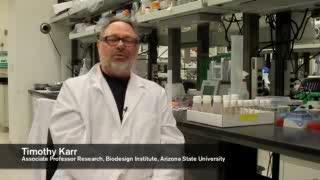Most importantly, the similarity in the genetic systems of fruit flies and other eukaryotic organisms including humans makes these model organisms extremely useful analogues for the study of common genetic processes including transcription and translation.
Roughly 75 percent of known human disease genes have recognizable correlates in the fruit fly genome and 50 percent of fly protein sequences have mammalian homologs. (The complete genome of D. melanogaster was completed in 2000.)
Chromosomes: genetic storehouses
Humans have 23 pairs of chromosomes, or 46 chromosomes in all. Of these, 44 are known as autosomes and consist of matched pairs of chromosomes, known as homologous chromosomes. Each homologous chromosome contains the same set of genes in the same locations along the chromosome, though they may appear in differing alleles, which can affect the passing of genetic traits.
The current study however, focuses not on the autosomes but on the remaining pair of chromosomes, known as sex chromosomes. Females contain two X chromosomes, which are homologous, as in the case of the autosomes. By contrast, males are identified as having one X chromosome and one (much smaller) Y chromosome.
While drosophila only have a total of 4 chromosomes, they too display sexual dimorphism, with females carrying the double X chromosomes and males carrying XY. The two X chromosomes in female fruit flies, as in mammals, make them a homozygous sex as compared with the XY condition in males, known as heterozygous.
"There are certain aspects to the composition of these sex chromosomes that have intrigued evolutionary biologists for a long time," Karr notes. One such issue involves an apparent reduction in the number or the level of expression of sex-linked genes on the X chromosome during spermatogenesis. It is believed that this reduction or silencing of genes on the X chromosome may have profound implications for the evolution of sex chromosomes.
During meiotic development of a sperm cell, nature attempts to compensate for the fact that females have two X chromosomes and therefore enjoy a numbers advantage in terms of genes, compared with males. To overcome the bias for female X-linked genes, the X chromosome undergoes inactivation during meiotic sexual differentiation of male gametes, resulting in an underrepresentation of sex-specific genes on the X chromosome. Some of these genes, which may be beneficial to males, are moved from the X chromosome, to the autosomes, where they may be expressed.
The relocation of male-biased genes to the autosomes may be due to a selective advantage favoring genes that move off the X chromosome and therefore avoid X-inactivation during meiosis. Such theories remain controversial however, as statistical analyses are used to evaluate gene frequencies and expression levels, making the proper categorization of genes particularly challenging. "The data we create and generate to support our ideas and hypotheses are messy, there's noise in them," Karr says. "Such noise is inherent in the history of evolution."
In addition to the steady stream of insights into chromosome evolution, Drosophila are being used as a genetic model for a variety of human diseases including Alzheimer's, neurodegenerative disorders, Parkinson's, Huntington's, as well as extending knowledge of the underlying mechanisms involved in aging, oxidative stress, immunity, diabetes, and cancer.

This video features an interview with Tim Karr, a researcher at the Biodesign Institute at Arizona State University.
(Photo Credit: The Biodesign Institute at Arizona State University)

This is the fruit fly Drosophila melanogaster.
(Photo Credit: André Karwath aka Aka)
Source: Arizona State University